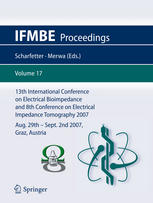

Most ebook files are in PDF format, so you can easily read them using various software such as Foxit Reader or directly on the Google Chrome browser.
Some ebook files are released by publishers in other formats such as .awz, .mobi, .epub, .fb2, etc. You may need to install specific software to read these formats on mobile/PC, such as Calibre.
Please read the tutorial at this link: https://ebookbell.com/faq
We offer FREE conversion to the popular formats you request; however, this may take some time. Therefore, right after payment, please email us, and we will try to provide the service as quickly as possible.
For some exceptional file formats or broken links (if any), please refrain from opening any disputes. Instead, email us first, and we will try to assist within a maximum of 6 hours.
EbookBell Team

5.0
30 reviewsThese proceedings continue the series edited in the framework of the traditional triennial International Conference on Electrical Bio-Impedance (ICEBI), the most important platform for presenting recent scientific achievements in the area of electrical bio-impedance. The XIII ICEBI was held from Aug. 29th – Sept. 02nd 2007 at the Graz University of Technology in Graz, Austria. As already in previous years the 13th ICEBI was held together with the 8th Conference on Electrical Impedance Tomography, the annual meeting for biomedical impedance imaging. Consequently, the proceedings also contain many contributions from this very important and challenging branch of bioimpedance research.
When compared to previous ICEBIs we notice a slight reduction of publications dedicated to purely theoretical models of bioimpedance phenomena while there was a significant increase of presentations on non-contacting and multimodal imaging technologies, cellular applications and specific biomedical applications. Among the latter pulmonary monitoring, multi-segmental BIA and cellular applications should be especially mentioned as obviously being in the transition from basic research to clinical usefulness.
The growth of interest for bioimpedance research is also reflected by two additional facts, namely the foundation of the International Society for Electrical Bio-Impedance (ISEBI) at the preceding conference 2004 in Gdansk and the kind endorsement of the 13th ICEBI by the IFMBE and its offer to publish scientific papers in the series of IFMBE proceedings.
Seeing all these favourable developments the editorial board is more than optimistic that bio-impedance research will continue its successful way and further contribute to the overall prosperity of biomedical engineering.